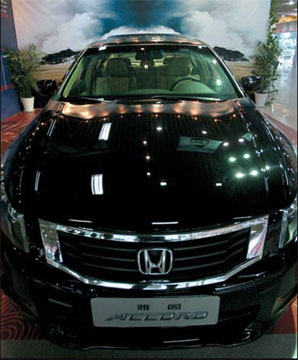China tooling up as integral cog in the worldwide auto industry
Today's global automotive industry is an increasingly complex and intertwined by its very nature. Several factors are driving both vehicle producing and vehicle consuming nations closer together everyday.
These include stiffening emission standards, the rise of global integrated vehicle manufacturers and new export possibilities as incomes grow. Others include the importance of technology to meet consumer expectations and regulatory challenges while seeking to communize components and structures to raise economies of scale and lower fixed costs.
Essentially, no country can flourish in this industry without integrating and coordinating actions with countries abroad. In today's industry, no man is an island. To truly flourish in the future, China must not build its own automotive industry but one that is truly an integral cog in global production.
The mindset is crucial and is at the forefront of thinking by China's decision makers.
Since earlier this decade, light vehicle sales and production volumes have grown at meteoric pace in China - something never witnessed before in the industry's history worldwide.
On the light vehicle side of the ledger, 2008 calendar year volume will reach almost 8 million light vehicle units - a rise of almost five-fold from 2000.
Not lost on the rest of the world is that as a single country, China's light vehicle production volumes are forecast to be higher than any other country by 2014, easily eclipsing Japan and the United States.
Virtually every major mass-market vehicle manufacturer is active in China as nobody wants to be on the outside looking in.
Historical context

It is crucial to understand how China's industry has reached its current position and the many lessons that were learned along the way.
In the 1970s, various joint ventures between Western OEMs and Chinese companies were formed to build older designs that were no longer technologically up to date for Western customers or governmental safety and emission standards. Whatever the case, China became the final production location for older, tired vehicles from global makers such as Volkswagen, Chrysler and Daihatsu. The Jeep Cherokee and first variations of the Volkswagen Passat sedan are two key examples of vehicles manufactured in China for Chinese consumers. Volumes were relatively low from a global perspective though the building blocks for greater integration were being laid, albeit slowly.
Until early in the decade, the bulk of light vehicle production and sales in China were older versions of vehicles from global vehicle manufacturers. Occasionally, the vehicles were modified to meet China's requirements with little thought for possible exports.
As the decade continued, Western OEMs were driven by several factors to offer China the latest global offerings available to other markets. The bulk of the vehicles currently in production in China are within the global product cycle, a trend that has accelerated as the domestic market rises in size and complexity.
Most consumers are keenly aware of the world's latest offerings while being offered an increasing array of choices. A recent study by CSM Worldwide found that the number of variations built in China by 2010 could be 50 percent higher than Japan, meaning there will be no shortage of selection for China's consumers.
Complex web
China's auto industry structure is almost as impressive as the growth itself.
Beyond the numerous joint ventures with Western vehicle manufacturers looking to benefit from the expansion of the domestic market, Chinese partners are gaining experience building world-class vehicles through an incredibly complex web of development, supply, logistics, capital, processes and execution. The inevitable consolidation of smaller domestic vehicle makers into larger entities is necessary due to the benefits of scale economies. No country has developed its automotive capability in the same fashion as China.
New capabilities are found in selected Chinese vehicle makers - those that need to field truly integrated entities able to compete on the global stage.
Chery, Shanghai Automotive Industry Corp (SAIC), First Automotive Works (FAW) and Geely are the most obvious examples of self-sustained abilities to develop, build and market offerings for global consumption.
The route of each has been different, depending upon its Western partners, approach and goals.
Chery has decided to utilize technology, scale-building and powertrain alliances to build its capability.
Deals with a number of Western component suppliers, Fiat in the powertrain arena and Chrysler on vehicle build and development highlight the multi-faceted approach by the Wuhu-based maker to reach critical mass. Quickly building a leading-edge industry entirely from within is not possible in today's integrated framework.
FAW and SAIC are using a combination of experience gained from Western partners such as General Motors, Volkswagen or Toyota to improve their capability to build their own portfolio. As is the case with other regions such as Japan, the US, South Korea and Europe, China will be home to two-three of integrated global vehicle makers - not only producing in China but increasingly active players in markets abroad.
Tomorrow's integrated vehicle makers will have to utilize global platforms to build offerings in several markets, not just one hub from which all markets are served. Instead, a global framework of production, supply and development is required to effectively address an ever-more complex market.
Expansion of the Japanese, South Korean and even European OEMs to lower currency risk from inter-linked global production facilities is the blueprint for any China-hubbed vehicle maker looking for success on the global stage.
The next level

China is not alone in building a sustainable industry able to compete on a global stage. Rising quickly - though from differing starting points and internal structures - are India and Russia. Aggressive domestic and international expansion of their auto industries evidenced by Tata's recent purchase of Jaguar and Land Rover and alliances between AvtoVaz and Renault.
So China is not alone in trying to build a sustainable industry as other countries have studied the growth patterns of emerging automotive superpowers. Another area of intense global competition will be the race to develop vehicles, powertrains and associated technologies.
New development hubs are cropping in several international locations and China needs to be part of this expansion to build a sustainable industry. Examples include the rise of GM's PATAC development operation in Shanghai as an integral cog in their global vehicle development network. Another is the fast ascent of Chery's development capabilities in Wuhu.
The battle of the brain is crucial going forward. Increasingly, vehicle execution is leveling the playing field - tomorrow's difference will emerge from technology integration and speed to market. Tata's recent purchase was driven by the need for access to technology and the ability to develop vehicles competitive on a global scale is evidence of the importance of this capability.
In the end, a few select China-based vehicle makers will emerge as global players over the next decade. Lofty goals such as reaching Toyota or General Motor's market dominance may never be attained, though there is ample room in the Top 10 for a sustainable player to exist. The building blocks have been laid and China's infrastructure will ensure it will be an integral cog in the global automotive wheel.
Michael Robinet is vice-president of Global Vehicle Forecasts for US automotive consultancy CSM Worldwide Corp.
(China Daily 04/18/2008 page14)














